
- Share via
The year 2024 had us hugging our cookbooks. They brought us solace, nostalgia, inspiration, delight, reclamation, beauty and deliciousness when much of the rest of the world seemed to induce fear and uncertainty.
Our list of favorites for 2024 includes something for every kind of food book lover.
Recipes came from a tiny creek in the Appalachians and the rice terraces of Yunnan. Through them, authors gave voice to their ancestors, explored identity, put spins on centuries-old traditions, shared their love for Sicilian sweets, Chinese breakfasts, heirloom beans.
This year’s list also features fresh books from many Los Angeles authors. Cook vegetables better with Sarah Hymanson and Sara Kramer’s “Kismet,” or make saag paneer lasagna and green chutney pizza from “Amrikan” by food writer Khushbu Shah. “Wafu Cooking” is a California take on “Japanese-style” fusion, by way of cooking teacher Sonoko Sakai. Former L.A. Times cooking columnist Ben Mims dives deep into cookies from around the world. And Adrienne Borlongan, founder of Wanderlust Creamery, shows us exactly how to re-create her wildly wonderful flavors for ice cream.
Here is L.A. Times Food’s list of the best cookbooks of 2024.

A Sweet Year: Jewish Celebrations and Festive Recipes for Kids and Their Families by Joan Nathan (Knopf) and My Life in Recipes: Food, Family, and Memories by Joan Nathan (Knopf)
After a seven-year break following the 2017 publication of her 11th cookbook, Joan Nathan emerged in 2024 with two new cookbooks, each a meaningful addition to the evolving story of food and identity. In “My Life in Recipes,” Nathan, as I wrote earlier this year, tells not only the story of how she became the world’s preeminent expert on Jewish food but also how her life and recipes reflect the ever-broadening tastes of the American palate and her lifelong search for what binds many disparate cultures together. More than 100 recipes, some updates of her classics and others she developed more recently, are woven into the memoir. In the brand-new “A Sweet Year,” organized with a chapter and overview for each Jewish holiday, Nathan has devised what should become a children’s cooking classic. With an inspired structure for teaching young cooks, each recipe specifies steps that can be done by the child alone, by the child with an adult and when the adult should take charge. And while there are fun kid-specific foods such as rainbow-colored challah and chicken schnitzel tenders, her book is full of recipes that cooks of any age would be proud to serve. — Laurie Ochoa

AfriCali: Recipes From My Jikoni by Kiano Moju (Simon & Schuster)
Kiano Moju’s “AfriCali” cookbook shares her perspective as someone who was born to a Kenyan mother and a Nigerian father, grew up in the Bay Area (with summers often spent visiting her Maasai family in Kenya) and has since traveled all over the world. Family ties are celebrated with her mom’s steak and capers and a handful of recipes from her grandmother, including Koko’s pancakes and Koko’s cabbage. But more often, Moju demonstrates the universality of the cuisines that shaped her with dishes that merge influences, such as berbere-braised pork tacos and mango and ginger scones, a pastry she perfected during graduate school in London. A culinary producer turned recipe archivist through her Jikoni Archive nonprofit, Moju’s book also shares insight into the culinary history of Kenya, including the influence of Arab traders who settled along the Swahili Coast. You’ll learn how international dishes are reinterpreted in the East African country, such as biriyani that layers saucy chicken over saffron rice and chai masala that can be used to make tea or other dishes that call for ginger. — Danielle Dorsey
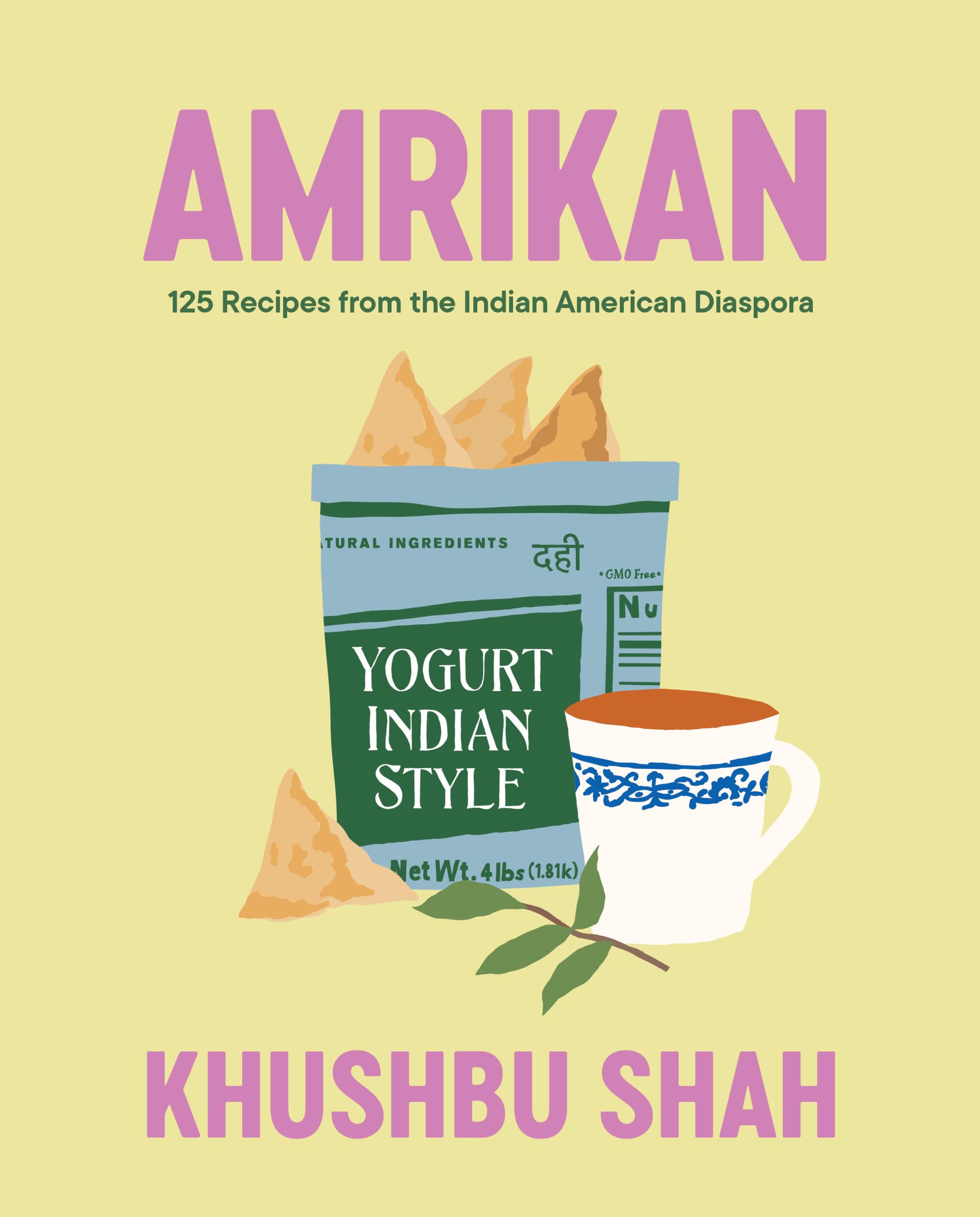
Amrikan: 125 Recipes From the Indian American Diaspora by Khushbu Shah (W.W. Norton & Co.)
For her debut cookbook, Khushbu Shah gathers recipes that blend traditional Indian dishes with the ingenuity of Indian mothers who substitute American grocery store items for hard-to-find ingredients. The resulting adaptations are delightful dishes of the diaspora that highlight the cuisine’s diversity. Named for the desi word used to describe something American, “Amrikan” contains recipes for green chutney pizza, saag paneer lasagna, tandoori chicken wings and masala deviled eggs. Former restaurant editor for Food & Wine, Shah uses color and humor to create a delicious world with visual aids like a rainbow chart of the Amrikan pantry, a three-panel guide on basic dosa making and “objects of the diaspora bingo” (Shoe pile by the door? Check! Yogurt container not filled with yogurt? Check!). I am obsessed with the photo of breakfast cereal chevvdo that uses Rice Chex, Kix and cornflakes in place of dried lentils and flattened rice, stored in a circular blue Danish butter cookie tin for true immigrant household authenticity. If you are a child of immigrants who ever asked your parents to please make a dish your friends would eat and got a little more than you bargained for, this book is for you. — Sarah Mosqueda

Be Ready When the Luck Happens by Ina Garten (Penguin Random House)
Bestselling cookbook author and Food Network personality Ina Garten has popularized phrases like “How easy is that?” and “Store-bought is fine,” making entertaining like a domestic goddess feel attainable rather than aspirational. Her latest release isn’t a cookbook in the traditional sense; it’s her long-awaited memoir, “Be Ready When the Luck Happens.” Her successful career is one she partly credits to luck, and fans get a deeper look at her life before she became the Barefoot Contessa and the skills she sharpened like a chef’s knife to get there. The few recipes included are choice ones that highlight memorable moments in her life: coq au vin, a classic French stew she had for the first time when she and her husband, Jeffrey, backpacked through Europe as newlyweds, for example. Or Emily Blunt’s English roasted potatoes, which the actress made with Garten on an episode of her television series “Cook Like a Pro.” This really is a memoir you can eat. How lucky is that? — S.M.

The Bean Book: 100 Recipes for Cooking With All Kinds of Beans, From the Rancho Gordo Kitchen by Steve Sando (Ten Speed)
Steve Sando is the man behind Rancho Gordo, the heirloom bean company you have no doubt seen at your local gourmet market or on the menu of your favorite restaurant. Sando has made a career of saving, sourcing, growing and cooking with heirloom beans and has inspired chefs and home cooks to explore heirloom varietals too. “The Bean Book” contains 100 recipes for cooking all kinds of beans using multiple methods from oven to pressure cooker. There are recipes for bean salads, bean soups, baked beans and bean patties and fillings. A section at the back includes recipes for bean accompaniments, like “Steve’s skillet cornbread,” which according to Sando is the best friend a bowl of beans ever had, aside from the corn tortilla. Sando insists you use his simple “master recipe for pot beans” at least once. “With no stock or pork or much of anything, I think you’ll see that bones and stock are not necessary for good beans,” he writes. — S.M.

Bethlehem: A Celebration of Palestinian Food by Fadi Kattan (Hardie Grant North America)
“Deciding to write about my Palestinian cuisine and share family stories, as well as celebrate some of the wonderful artisans of Bethlehem, felt natural,” chef Fadi Kattan notes in the introduction to the cookbook he spent over two years documenting and compiling. He wanted the recipes — framed by beautiful, sense-of-place landscapes and portraits conveyed in photographer Elias Halabi’s images — to be extensions of the conversations he has with guests in his restaurants in London and Bethlehem. Kattan is especially adept at guiding readers into the flavors of the region with something as simple as eggs fried in samneh (ghee) with a sprinkle of lemony sumac for breakfast. He also showcases his own respectful creativity, as in a dish of roasted eggplant, bathed in tahini sauce and covered with fragrant herbs, that’s essentially deconstructed baba ghanoush. The subject also being the civic embodiment of Christmas, Kattan concludes the book with an essay about his family’s celebration traditions and instructions for his grandmother’s holiday spiced fruitcake. Kattan could not have known that the release of the book would coincide with a yearlong war that has decimated the nearby Gaza Strip and killed thousands of Palestinians, but in that context, these pages become even more poignant records of preservation and humanity. — Bill Addison

Bodega Bakes: Recipes for Sweets and Treats Inspired by My Corner Store by Paola Velez (Union Square & Co.)
“Bodega Bakes” is the sweets-centered cookbook from Dominican American pastry chef Paola Velez, who grew up in the Bronx and frequented her local bodega for treats that ranged from traditional Caribbean desserts to M&Ms and Warheads. The recipes draw from these memories, often combining staple Afro-Latine ingredients with classic pastry recipes, such as café Madeleines with té de hoja and sticky buns with ripe plantains that celebrity chef Guy Fieri hailed as the best he’s ever tasted. Velez, who during the pandemic co-founded Bakers Against Racism, a community of bakers who raised $2.5 million for social justice causes through decentralized bake sales, offers innovative recipes you won’t find elsewhere (see: moringa-soursop swirled cookies and tamarind pecan pie) but are still approachable for home bakers who are just starting out, with many ingredients available at your local bodega or corner store. — D.D.

Café Cecilia Cookbook by Max Rocha (Phaidon)
Max Rocha serves my kind of aspirational food, the sort of meals I want to make daily — not because the Irish-leaning dishes at London’s Café Cecilia are ambitious and photo-worthy (though many are also that), but because they strike my ideal balance of simplicity and comfort. Those seasonal soups and pastas and salads and custards are also a world away, but thanks to the chef-owner’s debut cookbook, I can now re-create a bit of his wildly popular restaurant and cafe at home. A childhood spent helping his mother and grandmother in the kitchen translated to a love of baking when Rocha pursued professional cooking later in life. The result? A signature item at his own cafe that sings to his Irish roots and receives an entire chapter in the new book: Guinness soda bread, which can be enjoyed a la carte or with smoked mackerel páté or dressed crab or, when day-old, transformed into a Guinness treacle tart. Beyond the beloved bread, the cafe’s day-to-night history can be traced through the 100-plus recipes, from morning and afternoon treats such as cheese scones, potato rosti and sage-and-anchovy fritti (another signature dish) to a range of hearty braises and delightful champagne jellies studded with fresh raspberries. Use this book for everyday cooking or to host a pitch-perfect dinner party. — Stephanie Breijo

Chinese Enough: Homestyle Recipes for Noodles, Dumplings, Stir-Fries, and More by Kristina Cho (Artisan)
From the first pages of Kristina Cho’s book, I felt a kinship with the author. Being both Chinese and Eastern European, I’m often pulled in two directions. I too have been accused of not being “Chinese enough.” Cho’s experience is instantly relatable, whether you’re grappling with your own identity or not. Part cookbook and part autobiography, the recipes help weave the narrative of her experience as a first-generation American-born child of immigrants. This is Chinese food with a California slant, with plenty of substitutions and tips to make the food your own. Her cheesy chrysanthemum and mushroom pockets combine all the best parts of Chinese chive pockets and Hot Pockets. She makes rangoon with smoked mackerel and tosses kohlrabi and watermelon radishes in chili crunch. There are the more traditional recipes too, like steamed pork cake with chives and cilantro. And the overarching theme is one we could all use more of: You, whoever you are, are enough. — Jenn Harris

Crumbs: Cookies and Sweets From Around the World by Ben Mims (Phaidon)
There are so many ways to appreciate former L.A. Times cooking columnist Ben Mims’ magnum opus on the topic of cookies. With 300 recipes and matching images for many of them, the book covers more shapes and styles and levels of difficulty than a single mind could imagine, from the simplest shortbread to worthy projects like Algerian-Tunisian date-filled semolina cookies fried and rolled in honey syrup. It’s cookie tome as personality test: What draws us most tells us who we are. In that vein, Mims also uses the subject as a dive into history, tracing the origin of the cookie to Persia and organizing sections by global regions. Headnotes reveal the depth of his research. As one tiny example, he’ll lead bakers who find they enjoy the richness of sweetened condensed milk in Estonian cookies to Peruvian macaroons and Brazilian sequilhos that similarly feature the ingredient. Mims even tackles the “What is a cookie?” question with a philosopher’s seriousness. Which is all to say: While the snickerdoodles are in the oven, you’ll likely lose yourself in the smart writing. — B.A.

Di An: The Salty, Sour, Sweet and Spicy Flavors of Vietnamese Cooking With Twaydabae by Tuệ Nguyễn (Simon Element)
Tuệ Nguyễn is known as Twaydabae to her hundreds of thousands of fans on social media. Her warm, vibrant personality and enthusiasm are palpable in each bubble-gum-pink page, in each recipe intro, smiling photo and illustration. This is Nguyễn’s love letter to her Vietnamese heritage, with recognizable Vietnamese classic recipes and more modern takes she’s made all her own. Of course it makes sense to make birria tacos with the spicy Vietnamese beef stew bo kho, and to infuse a burger with the black pepper, onions and peppers of bo luc lac. You’ll find a chapter of Nguyễn’s most internet-famous dishes, with a “viral fried rice” studded with lap cheong; her chili oil noodles with lemongrass; and a seafood boil with angel hair pasta. Keep this book around for midweek dinner ideas or a full blueprint for every dish you might want at your next dinner party. — J.H.

Dolci: American Baking With an Italian Accent by Renato Poliafito with Casey Elsass (Knopf)
For a blend of Italian baked goods old and new, “Dolci” can’t be beat. That’s because author and first-gen Italian American Renato Poliafito channeled his heritage and his growing pains into a career and a new cookbook that seamlessly integrate Italian, American and Italian American techniques and flavors. The owner of New York’s Pasta Night and Ciao, Poliafito spent much of his adolescence torn between his upbringing in New York and familial visits to Sicily: seen as an Italian while in America, seen as an American while in Italy. In “Dolci” he provides traditional recipes (bombolini, crostate, struffoli, cassata, gelati) as well as many of his own inventions, reimagining the iconic Sicilian cuccidati cookies into scones, baking up a festive gingerbread take on amaretti, and glazing zeppole with a sweet-salty tahini sauce. But Poliafito’s “Dolci” isn’t just about sweets. The baker also walks us through savory treats like sourdough focaccia and cacio e pepe arancini, as well as a handful of aperitivi, or spritz-like cocktails, for a bridging of cultures across any time of the day. — S.B.

Flavorama: A Guide to Unlocking the Art and Science of Flavor by Arielle Johnson (Harvest)
Arielle Johnson — a food scientist who helped establish the fermentation lab at Noma in Copenhagen and an advisor to some of the world’s top chefs — breaks down how we experience flavor. What we taste refers to salty, sour, sweet, bitter and umami — that’s it, that’s all our tongues have receptors for. “Just about everything else is smell,” Johnson writes. The grassiness of herbs, the anisic notes of fennel, the marine flavors of seaweed, the tropical-ness of pineapple ... these come from molecules translated by our scent receptors. Johnson goes deep to explain the multidimensional sensations of flavor and how we can build on these to improve our cooking. Recipes are approachable, easy to follow and flavor-boosting, and the science behind them makes for a fascinating read. — Betty Hallock

Greekish: Everyday Recipes With Greek Roots by Georgina Hayden (Bloomsbury)
I appreciate the ethos of Georgina Hayden’s “Greekish,” a casual, I-do-what-works-for-me approach to cooking inspired by her Greek Cypriot heritage. It’s still a deep dive into the cuisines of Greece and Cyprus, with an acknowledgment of influences from the Jewish community in Thessaloniki, the Venetian occupation of Corfu and the neighboring countries of Bulgaria and Turkey. Recipes are clearly labeled as vegetarian, vegan and/or gluten-free, and chapter divisions are playful and useful, devoted to “things on sticks,” “everyday heroes” and “feasts.” Her many interpretations of baklava are reason enough to buy the book. Baklava buns are cinnamon buns reimagined with a tahini cream cheese frosting and ground cinnamon and toasted walnuts. There’s baklava ricotta semifreddo and baklava cake. The baklava cheesecake is a triumph, with a flaky filo crust and a smooth, creamy filling of feta, cream cheese and white chocolate. — J.H.
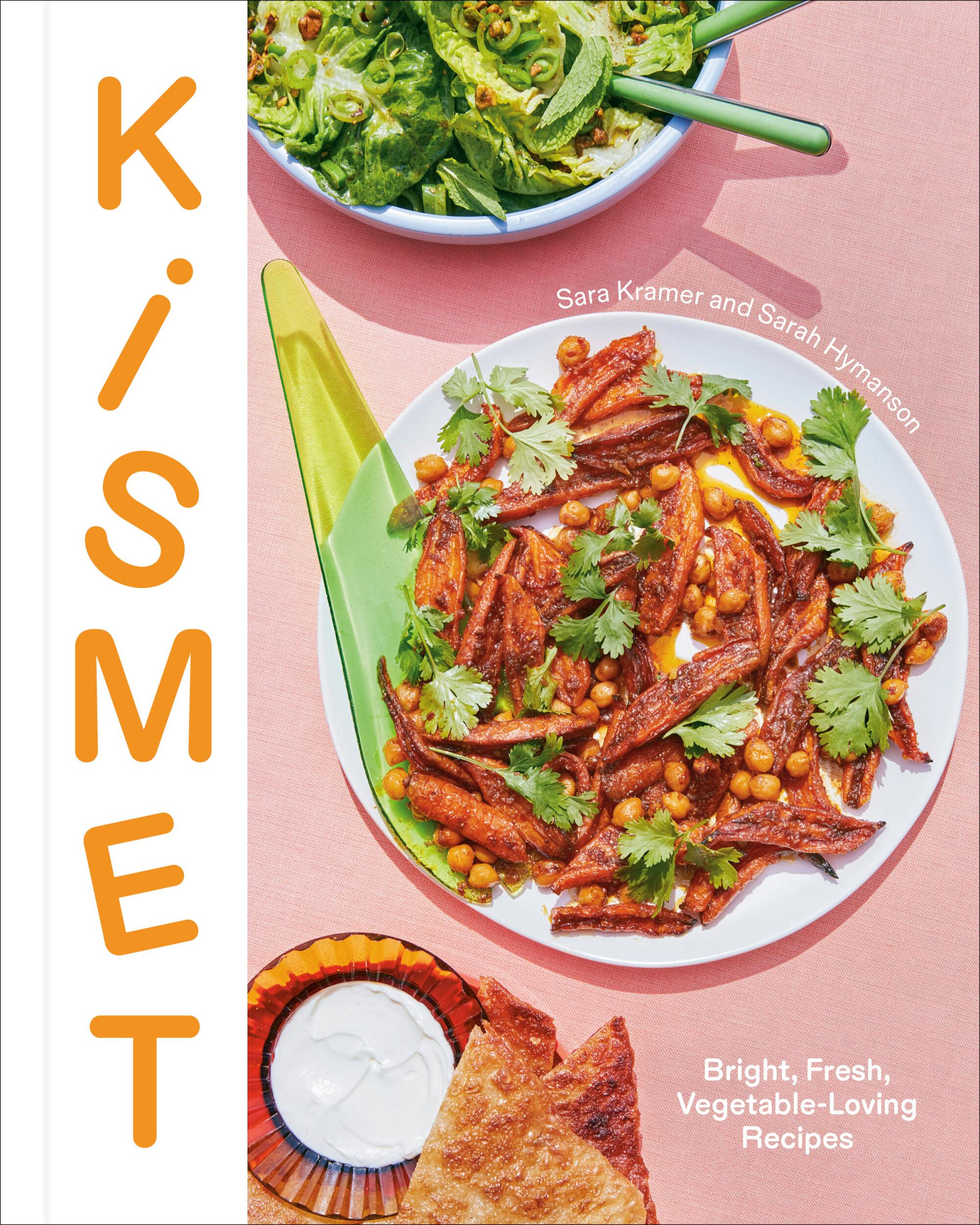
Kismet: Bright, Fresh Vegetable-Loving Recipes by Sara Kramer and Sarah Hymanson (Ten Speed)
This is a book for anyone who loves vegetables, and everyone who wants to be inspired to cook them in fresh and surprising ways. Sarah Hymanson and Sara Kramer are the two L.A. chefs behind Kismet restaurant in Los Feliz and the Kismet Rotisserie takeout shops (where the tahini roasted cauliflower is as popular as the chicken). How is it that the duo can create seemingly simple dishes of mostly vegetables (and a little meat too) in smart, surprising ways with so much compelling, complex, zingy flavor? Thoughtful, colorful, delicious recipes — which often meet where sunny California and Eastern Mediterranean cooking intersect — go a long way in showing us how. Bright salads (a cucumber number they can’t take off the menu), bold and zesty vegetables in surprising combinations (grapefruit and spice-roasted tomatoes with feta) and comforting one-pot meals (a soup for breakfast, lunch or dinner) make you want to rush to your nearest farmers market. — B.H.

Koreaworld: A Cookbook by Deuki Hong and Matt Rodbard (Clarkson Potter)
In the follow-up to their 2016 bestselling cookbook “Koreatown,” authors Deuki Hong and Matt Rodbard think even bigger. They expand beyond the flavors of the Korean American diaspora with “Koreaworld” and dig into Korean cuisine’s “global evolution” with recipes and interviews from home cooks, professional chefs and tastemakers around the world. Recipes for smoked giant short ribs and cabbage-and-persimmon kimchi and banana-milk cake and rose tteokbokki and knife-cut noodle soup with perilla-seed powder are interspersed with local profiles and lists of favorite dishes, making it an indispensable travelogue as well as a cookbook. They traverse Korea’s dense cityscapes and pastoral provinces and return to American Koreatowns to plumb the depths of food as culture, musing on where it’s been and where it’s heading. Photographer Alex Lau’s visual work jumps off the pages in candid moments and bright splashes of color, due in part to the fact that all of “Koreaworld’s” images were shot on-site in restaurants and taverns and bustling streets, matching the energy and motion of Hong and Rodbard’s words. — S.B.
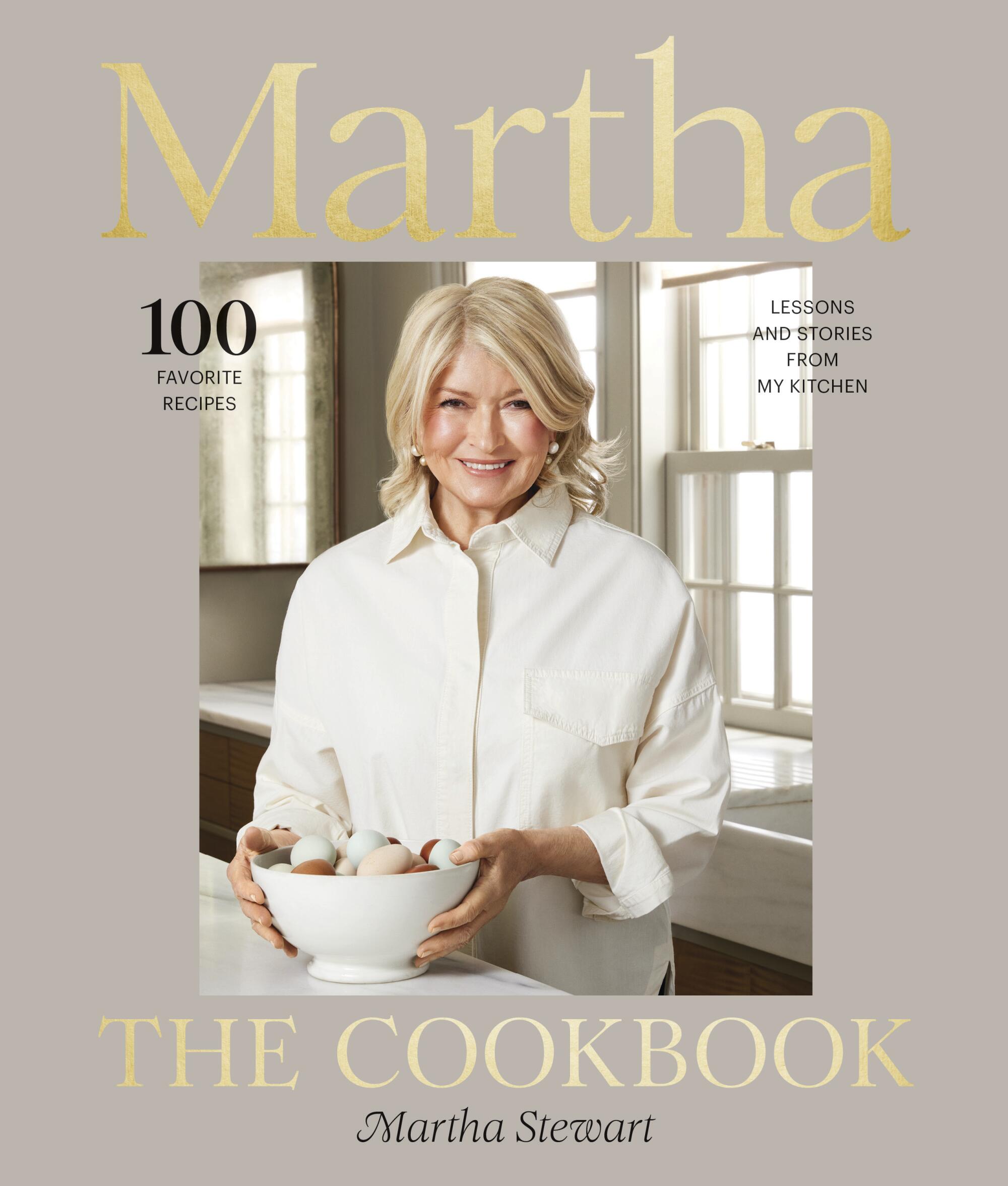
Martha the Cookbook: 100 Favorite Recipes With Lessons and Stories From My Kitchen by Martha Stewart (Clarkson Potter)
In her 100th cookbook, Martha Stewart shares 100 of her favorite recipes and an intimate glimpse into her personal life. Black-and-white photos of Stewart, her family and significant places and milestones over the years are peppered throughout the recipes. She writes like she’s regaling guests at a dinner party, sharing her family’s birthday cake traditions, revealing that Robert Redford was a regular at the Westport, Conn., shop she opened after leaving her job on Wall Street and explaining why she always has a chicken-coop complex on any property she calls home. She shares the recipe for her mother’s pirogis, plump with silky potato in a brown butter sauce with fried sage. There’s her miso eggplant inspired by friend Nobu Matsuhisa. Each page is a reminder of why Stewart is the queen of entertaining, with a well-curated mix of recipes and tips that are approachable and aspirational. — J.H.
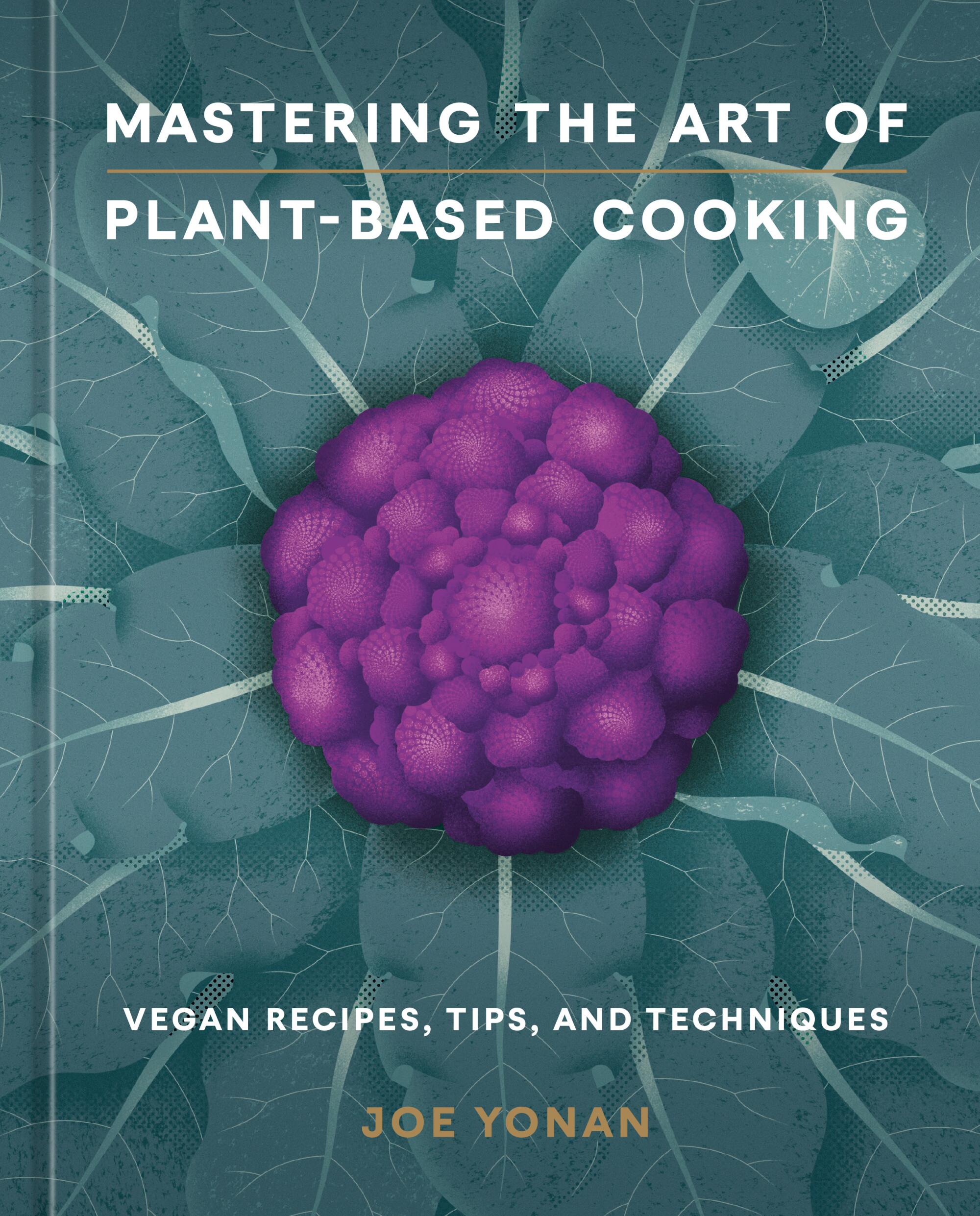
Mastering the Art of Plant-Based Cooking: Vegan Recipes, Tips, and Techniques by Joe Yonan (Ten Speed Press)
This is a book designed to appeal to every diet and persuasion, whether you’ve been plant-based for years or just starting to flirt with the idea. Joe Yonan introduces the basics, building the foundation for a myriad of meals that begin with nut, seed and oat milks, creams, yogurt and cheeses. The sheer number and variety of foods is astounding, with plant-based versions of every imaginable condiment, dressing and crisp represented and a total of more than 450 recipes. The most compelling dishes celebrate actual vegetables, like the whole roasted beets with mole; huitlacoche and zucchini blossom tacos; and squash and cabbage salad with roasted grapes and olives. But my favorite part of the book might be the guest essays, written by some of the brightest, most insightful food writers of our time. Nico Vera on decolonizing our diets feels especially relevant. — J.H.

Ottolenghi Comfort: A Cookbook by Yotam Ottolenghi with Helen Goh, Verena Lochmuller and Tara Wigley (Ten Speed)
Chef Yotam Ottolenghi and his co-authors define comfort food as simultaneously nurturing, convenient, nostalgic and indulgent. That’s the best way to describe the recipes in “Ottolenghi Comfort: A Cookbook.” The Israeli-born British chef, restaurateur and author taps friends and contemporaries Helen Goh, Verena Lochmuller and Tara Wigley to join him in sharing recipes they turn to again and again. When Ottolenghi’s first cookbook debuted in 2008, the shift in how cooks prepared and ate vegetables was widely regarded as the “Ottolenghi effect.” With this latest book, he’s poised to shift our viewpoint yet again, showing that comfort food is not necessarily culturally specific. The pages contain recipes for a spectrum of internationally influenced dishes such as German-style sausage rolls, lemongrass and galangal tuna curry and egg sambal “shakshuka.” I was delighted to find a recipe for tortang talong, a Filipino eggplant omelet, that wasn’t part of my childhood but is a favorite of my spouse who introduced me to the dish. Reimagined with ground lamb and harissa, this version feels like something new while still tasting like home. — S.M.

Praisesong for the Kitchen Ghosts: Stories and Recipes From Five Generations of Black Country Cooks by Crystal Wilkinson (Clarkson Potter)
Novelist and poet Crystal Wilkinson writes movingly about her Black Southern Appalachian foremothers, giving shape and voice to her family’s kitchen ghosts — those who passed their rural Kentucky foodways from generation to generation. “These women, some of them dead for 200 years, still affect the ways in which I hold my hands,” she says. The memories are palpable: “She held long-necked yellow squash as gentle as babies.” The recipes, from matriarchs in a tiny corner of the hills of Casey County, are universally appealing: jam cake, a good pot of seasoned greens, chicken and dumplings, Benedictine sandwiches and chess pie. One of the suggestions for baking skillet cornbread is to line the bottom of the pan with sliced onions before pouring in the batter. So the result is an onion upside-down cornbread. Regarding pimento cheese, Wilkinson takes a hard line. “I prefer to mix by hand rather than in a food processor. To those who use that appliance … I can hear my grandmother say, ‘Whoever heard of such?’” — B.H.

Richard Hart Bread: Intuitive Sourdough Baking by Richard Hart and Laurie Woolever (Clarkson Potter)
“Oh, that’s Richard Hart,” says Marcus, the pastry chef on FX’s “The Bear” portrayed by Lionel Boyce, when a colleague asks him about a picture taped to his workstation for inspiration. This isn’t TV fiction: Hart was a chef in London, where he was born, before moving to the Bay Area and falling in love with bread baking. His job as the lead baker at Tartine led to opening Hart Bargeri in Copenhagen with Rene Redzepi (with a bakery called Green Rhino soon to open in Mexico City). What makes this book different from others on bread baking, as Hart addresses immediately in the introduction, is that he’s “more of a sensualist than a scientist.” So while there can be no circumnavigating the necessary sourdough starters, the weighing of ingredients and the precision of recipes, something of Hart’s famous ebullience translates on the page. He is the guide who urges you to mix dough by hand, to inhale the aromas of bread through every step. And he isn’t precious or limited about variations. He includes a cheese loaf inspired by his time baking at Wild Flour Bread in Freestone, Calif. — the kind of indulgence, filled with pockets of cheddar and smoked Gouda, designed to be consumed whole before it even cools. — B.A.

The SalviSoul Cookbook: Salvadoran Recipes and the Women Who Preserve Them by Karla Tatiana Vasquez (Ten Speed Press)
The comforting sopa de res, savory panes con pollo and other Salvadoran dishes featured in “The SalviSoul Cookbook” will entice any reader and likely raise childhood memories for those who are part of the Salvadoran diaspora. Vasquez’s cookbook, which debuted this spring, is the first Salvadoran cookbook to appear on a Big Five imprint. “SalviSoul” features 80 defining Salvadoran recipes — with allowances for modifications, as many Salvadoran cooks in the U.S. for decades have had to resort to alternative ingredients — and shares the compelling stories of the matriarchs behind them. For instance, there’s a recipe for rellenos de papa from Patricia De La Torre, a woman who feels that the L.A. earthquake she experienced on the day she met her future husband may actually have been a warning for the turbulent relationship to come. In an April interview with The Times, Vasquez said that writing a cookbook with stories was important to her because that’s how she came to understand her own Salvadoran upbringing. — Cindy Carcamo

Second Generation: Hungarian and Jewish Classics Reimagined for the Modern Table by Jeremy Salamon and Casey Elsass (Harvest)
If you’re familiar with the menu at Crown Heights restaurant Agi’s Counter, then you know chef Jeremy Salamon spins fresh takes on Jewish and Eastern European classics such as palacsinta (warm buttered crepes rolled with whipped farmers cheese), chicken liver mousse (the secret ingredient is cream cheese) and fluffy semolina dumplings showered with dill. In his first cookbook, Salamon says he’s layering his “cheffy instincts over centuries of traditions. … I’m reimagining those traditions with an eye toward seasonality, market ingredients and a touch of millennial flair.” That flair shows up in borscht fragrant with chamomile vinegar and bay leaves; Persian cucumbers slathered with buttermilk ranch and grated horseradish; and squash blossoms stuffed with körözött, also known as Hungarian pimento cheese. Two chapters are devoted to dessert — one entirely for cakes. I’m all in on pancake torte. — B.H.

Sicily, My Sweet: Love Notes to an Island, With Recipes for Cakes, Cookies, Puddings, and Preserves by Victoria Granof (Hardie Grant)
Given Sicily’s history, its cookies, cakes and pastries are some of the widest-ranging in flavor and provenance: the byproduct of an island visited and conquered by the Greeks, Phoenicians, Normans, Spaniards, Romans, Goths and more. Victoria Granof has spent years as a pastry chef, food stylist and semiprofessional Sicilian-sweets historian, uncovering her own heritage through this region’s worldly baked goods. In her latest she covers all manner of the varied treats found there, and in one of the most stylish releases of the year: Baskets brim with marzipan shaped into cherries and just-ripe oranges; little almond cookies flavored with cherries, rose, saffron, lemon and ginger lie daintily on vintage dishes and lace doilies; hands dunk sweet buns into bowls of cream and rip open fluffy doughnuts spilling with ricotta. But Granof’s “Sicily, My Sweet” isn’t just aesthetically pleasing. The author delves into the traditions and superstitions of these items, and also provides guidance on building a Sicilian pantry, measuring by the eye and the hand (as my own Italian American grandmother tended to do), and even how to make your own sambuca to wash it all down. — S.B.

Soups, Salads, Sandwiches: A Cookbook by Matty Matheson (Ten Speed Press)
The creativity abounds in Matty Matheson’s latest, an ode to the simpler pleasures in life: soups, salads and sandwiches. In the third cookbook by the Canadian chef, internet personality and “The Bear” producer and actor, all three culinary subsets get some inspired — and sometimes flat-out strange — upgrades, like a single giant meatball floating in a tomato-y stew or a grilled cheese sandwich that oozes not only dairy but squash and bee pollen. There’s a shrimp burger, corn-and-maple soup and a fried-fish sandwich that gets ladled with clam chowder, but there are also straightforward classics of the three genres: gumbo, a wedge, a cheesesteak, a McRib riff, larb, crab congee and more. While I cooked my way through a few recipes I found some alterations were necessary, namely to my own tastes, but that’s by and large the crux of this cookbook: Matheson wants readers and home cooks to have fun with it, get weird and not take anything too seriously. That’s the joy of “Soups, Salads, Sandwiches” and what everyone’s favorite loud, tatted and endearingly chaotic chef calls “freewheeling cooking.” —S.B.

Stacked: The Art of the Perfect Sandwich by Owen Han (Harvest)
L.A.-based Owen Han, creator of spectacularly successful sandwich content, wrote his first book, and it’s highly cookable. Yes, it’s all sandwiches — who doesn’t love them? — that means his very broad definition (some would argue too broad) of what constitutes a sandwich (tacos?) ends up serving many readers well. There are more recipes than you might expect. One highlight is his Italian nonna’s recipe for meatballs. I like her meatball-making method: Use bread soaked in milk instead of breadcrumbs, and poach them directly in the tomato sauce rather than pan-frying first. They turn out incredibly tender and flavorful. It’s the recipe that sold me on this book, whether you put them in a sandwich or not (I have some in the freezer ready for spaghetti). I’ve cooked other components for sandwiches (the chile-marinated chicken for his O.G. Chicken Sandwich, for example), and even sans bread, they can be the start of an approachable weeknight dinner — or, of course, the makings of your next favorite sandwich.—B.H.

Wafu Cooking: Everyday Recipes With Japanese Style by Sonoko Sakai (Knopf)
Wafu translates to “Japanese style”; when it comes to cooking, that means hybrid dishes from other cuisines prepared with Japanese ingredients, flavors or techniques. Los Angeles-based cook and writer Sonoko Sakai delves into the transmutable character of this kind of fusion. Curry, croquettes, even ramen are national dishes that are the result of cultural intermingling. Sakai creates her own wafu recipes, including dashi cheese grits with miso honey butter, Japanese Italian wedding soup (she adds soy sauce and sake to her meatballs), Caesar salad with aonori croutons and bonito flakes, eggplant katsu curry, fish and lotus chips with wasabi tartar sauce, and balsamic shio koji chicken. They reflect a foundation in Japanese cuisine, matched with international influences and her passion for California’s bounty — citrus, persimmons, avocados, chiles and greens among them. Fresh and fun. — B.H.

When Southern Women Cook by Various Authors (America’s Test Kitchen)
From a diverse collection of chefs, restaurateurs, journalists, farmers and food professionals, “When Southern Women Cook” explores the challenges and triumphs of the women who feed the American South. History is woven through recipes for North Carolina cheese biscuits and Texas breakfast tacos, while humor and cultural criticism find their way into hash browns that recall the version served at Waffle House restaurants. Dishes such as grilled ramps and gobi Manchurian remind readers of the culinary traditions that existed long before cuisine categorizations, as well as the international influences that are apparent in Southern cooking thanks to generations of migration and movement. Recipe instructions are clear and straightforward, allowing home chefs of any level to conquer Southern staples such as pimento cheese, fried catfish or fresh peach pie. — D.D.

Wanderlust Creamery Presents: The World of Ice Cream by Adrienne Borlongan (Abrams)
Adrienne Borlongan’s cookbook is like a textbook, with every morsel of information one might need to understand the science behind ice cream. Using her background in food science, the Wanderlust ice cream shop founder explains what it is and exactly why it tastes so good, then introduces you to flavors from all over the world. The salted kaya toast ice cream marries a custard made with pandan leaf and salted duck egg yolks with slices of milk bread to mimic the popular breakfast in Singapore. Kinako and Kyoho grape jelly is Borlongan’s answer to American peanut butter and jelly, with the malty, nutty tastes of roasted soybean flour and fruit jelly. By the end of the book I was inspired to create my own flavors based on my travels. But then I remembered how good the ube malted crunch is and made another batch of that instead. — J.H.
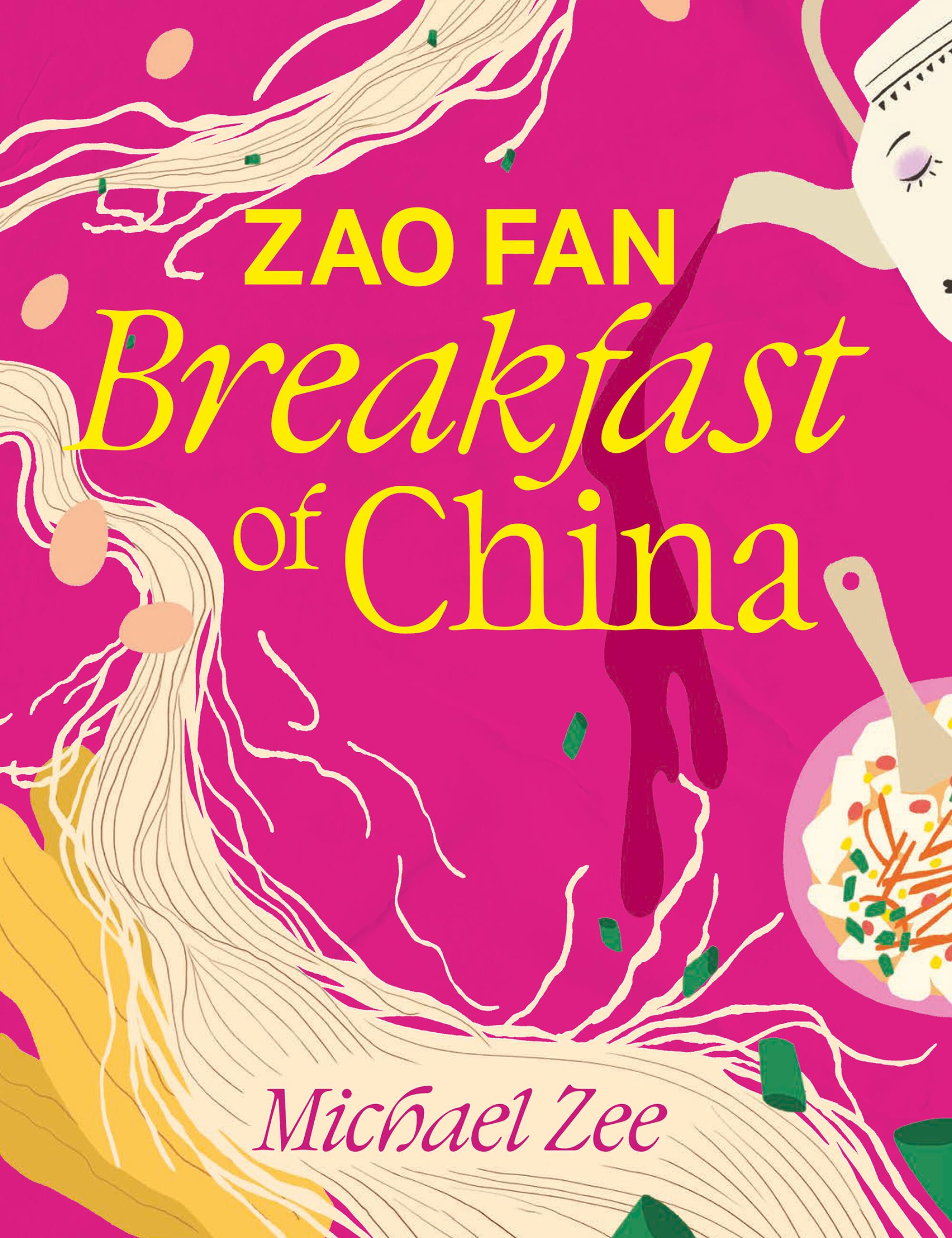
Zao Fan: Breakfast of China by Michael Zee (Interlink Books)
Michael Zee — the cookbook author behind the wildly popular Instagram account @symmetrybreakfast — grew up in his Shanghainese grandfather’s Chinese restaurants in Liverpool, England. When he moved to China in 2017, Zee set out to explore the craft of making breakfast, the most accessible meal of the day, all over the country. Recipes include morning soup, buns, noodles and dumplings in spectacular variety — Jjidan hanbao pancakes stuffed with egg and pork and sprinkled with white pepper, fluffy Xinbonese bread, creamy Yunnan rice pudding. “If we consider the country a vast tapestry of flavor, texture and processes,” Zee writes, “then the meal of breakfast is an elemental thread in a story that is still being woven.” There’s no other book about Chinese food like this one. — B.H.
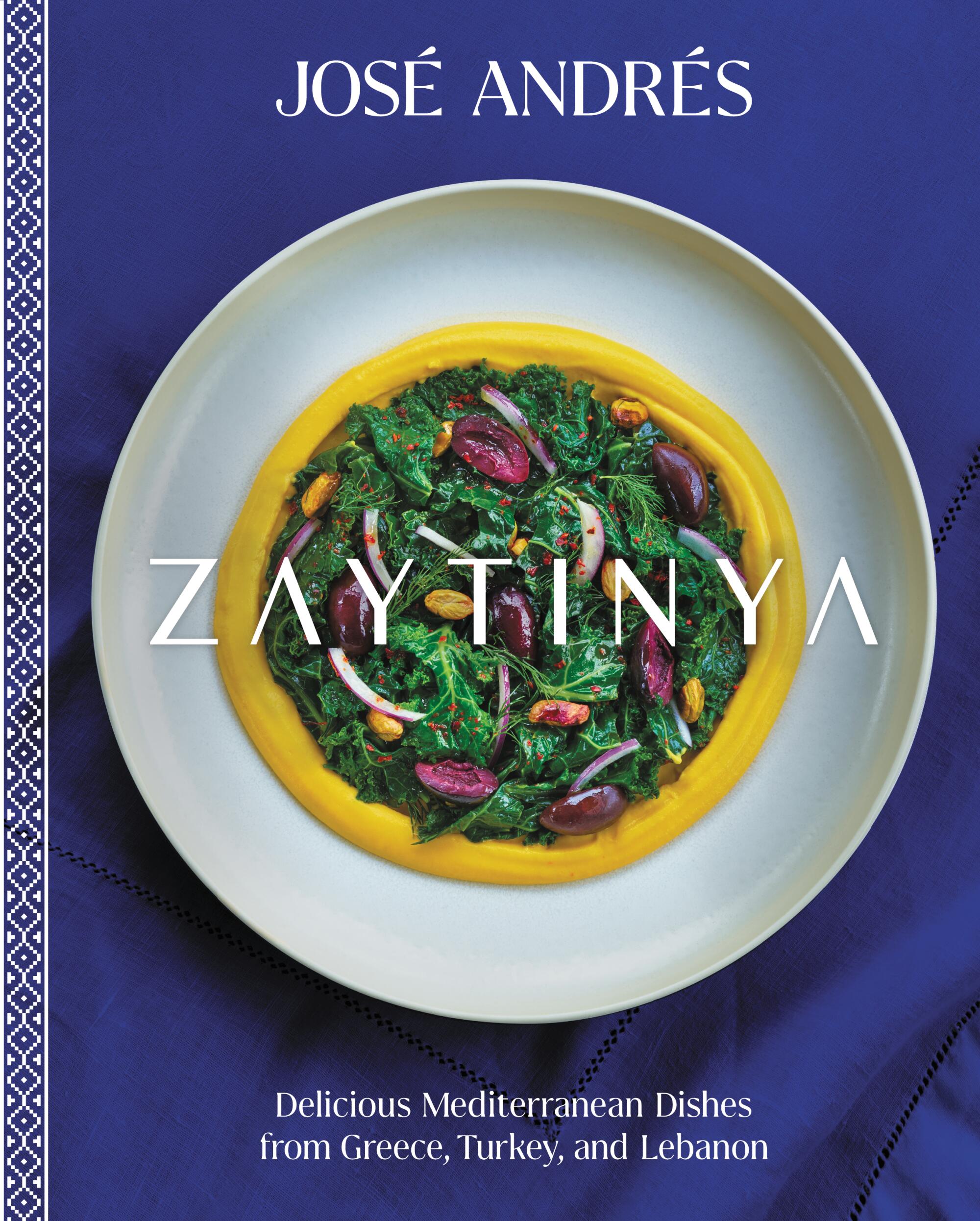
Zaytinya: Delicious Mediterranean Dishes From Greece, Turkey, and Lebanon by José Andrés with Michael Costa (Ecco Press)
Fans of Zaytinya have been waiting more than two decades for a cookbook. This year, José Andrés finally gave it to them. The celebrity chef’s celebrated, D.C.-founded restaurant pulls recipes and inspiration from the Middle East and the Mediterranean, and is famed for its mezze and grilled meats — sometimes prepared traditionally, sometimes with haute flair. In the “Zaytinya” cookbook, Andrés and the restaurant’s chef Michael Costa deliver most of the signature items along with the stories behind them, and build your pantry from the ground up, with recipes for Lebanese seven spice, Yemeni seasoning blends, preserved lemons, harissa chile crisp and more. Then, of course, comes the rainbow of mezze, the array of stuffed vegetables, the bevy of hearty large-format meat dishes and the after-dinner sweets such as olive oil cake and Turkish ice cream. But it’s also a celebration of the region: Andrés pays equal homage to Lebanon, Turkey and Greece, even titling some items in multiple languages and providing cross-cultural context, a nod to ubiquity and cultural ties. “The meaning to me of culture is not something exclusive, but something inclusive,” he told The Times this year. “It’s not something that only belongs to you, but belongs to everybody. Culture to me is the perfect synonym for longer tables, for sharing.” —S.B.
More to Read
Eat your way across L.A.
Get our weekly Tasting Notes newsletter for reviews, news and more.
You may occasionally receive promotional content from the Los Angeles Times.

















